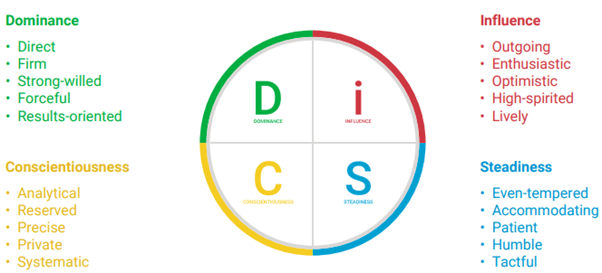DiSC® Assessments are a surefire way to enhance your training outcomes by providing the inside scoop on your learners’ personalities – in advance!
Imagine you walked into a room full of participants to conduct a training workshop and a Sci-Fi lens showed you people’s personality characteristics even before you said Hello to them. Feels like cheating the system, doesn’t it?
But in fact, it’s a real, useful way to be a more effective trainer. There’s a tool known as the DiSC® Assessment that can tell you about your participants’ personality styles in advance. Using that knowledge, you can create training activities that let everyone feel like the session is designed just for them.
This article is aimed at helping you equip yourself with the DiSC® Assessment system for enhancing the participants’ learning and actual application of those learnings in their jobs.

What is DiSC® Assessment?
Let’s start by looking at the DiSC® assessment system.
William Moulton Marston, a renowned psychologist, developed the first version of the DiSC® model back in 1928. It was later turned into an assessment instrument and has been evolving ever since.
The foundation of the DiSC® model is that people can be divided into four major personality types: Dominance (D), Influence (i), Steadiness (S), and Conscientiousness (C).
Based on an advanced testing method using Adaptive Testing (AT), individuals respond to assessment questions and the intelligent DiSC® engine gives you your personality type which could be a D, i, S, or C, or a blend of these personality styles.
The figure above shows every category’s salient traits. But that’s just the start. The powerful DiSC® system has the capability to generate bespoke reports providing insights into every aspect of the individual’s personality like her Workplace dispositions and her Management profile.
Harness the Power of DiSC® Assessments for Effective Facilitation
So, as a facilitator or a training manager, the DiSC® assessment will give you practical strategies to maximize the participants’ learning based on their personality type and learning preferences.
Walk into a training room with this knowledge and you’ll be able to immediately read the room accurately. That’s your superpower. You’ll be able to engage ALL your learners in a way that makes sense to them. And when learners are engaged, they’re more likely to learn and apply what they learn.
So how do you adjust your facilitation style to engage your learners? Keep reading!
Facilitating the ‘D’ style learners
The Ds are fast-paced dominators. They need action and stimulus more than others. To keep them engaged, keep your Ds at the center of the activities you’ve designed for the session. Moreover, if possible, get their buy-in before the training by asking for their comments on what should or shouldn’t be in the course contents. They’ll religiously follow the entire program if they get a sense of participation in the design of the contents.
In an ice-breaking session, Ds are the best ones that can be asked to start by introducing themselves. Others will join in automatically.
Keep an eye on them if the pace of the training is on the slower side. Ds are the first ones to get bored and eventually disengage altogether.
Facilitating the ‘i’ style learners
‘I’ style learners get energized by social interactions and an upbeat environment. When grouping participants for activities, make sure to keep a few i-style participants in every group. They will keep the groups together using their gift of charm.
For these types of learners, try to give them a clear scheme of learning and keep a follow-up on them constantly because they may get distracted by other things going on in the room.
Publicly encouraging them after every achievement, no matter how small, will keep them engaged and motivated.
Facilitating the ‘S’ style learners
These are stability lovers so stay predictable with them. It’s better to make sure they know the entire scheme of activities beforehand. While the previous two styles thrive in groups, an S will be fine working with or without a group. A combination of both is the best way for them.
When it comes to providing them with feedback on their performance, avoid highlighting their weak areas in front of others. They’ll take it personally and won’t cooperate, leading to a sharp decline in their engagement and learning levels.
Facilitating the ‘C’ style learners
Stay aware of their analytical tendencies resulting in a slower learning pace. Keep them with you by making sure they aren’t feeling rushed.
Your C participants don’t want to work in a group. Whenever possible, let them work on their own but encourage them to finish their tasks in the allotted time. They are your best bet for activities requiring deep thinking and self-reflection.
Cs can easily go down a rabbit hole and take up too much of others’ time when assigned a task or asked for their comments. Keep them on the right track through effective and active moderation.
Learn About DiSC® Assessments With Discprofiles4U
Knowing your participants’ DiSC® personality type gives you a clear edge over other training professionals because you are walking into the room with a wealth of information about your participants.
If you aren’t already using DiSC® Assessments, you’re missing out on many opportunities for a fulfilling career.
Head over to our Everything DiSC® Training Certification page to know more about our best-in-class DiSC® training which is a definite way to take your career to the next level.


